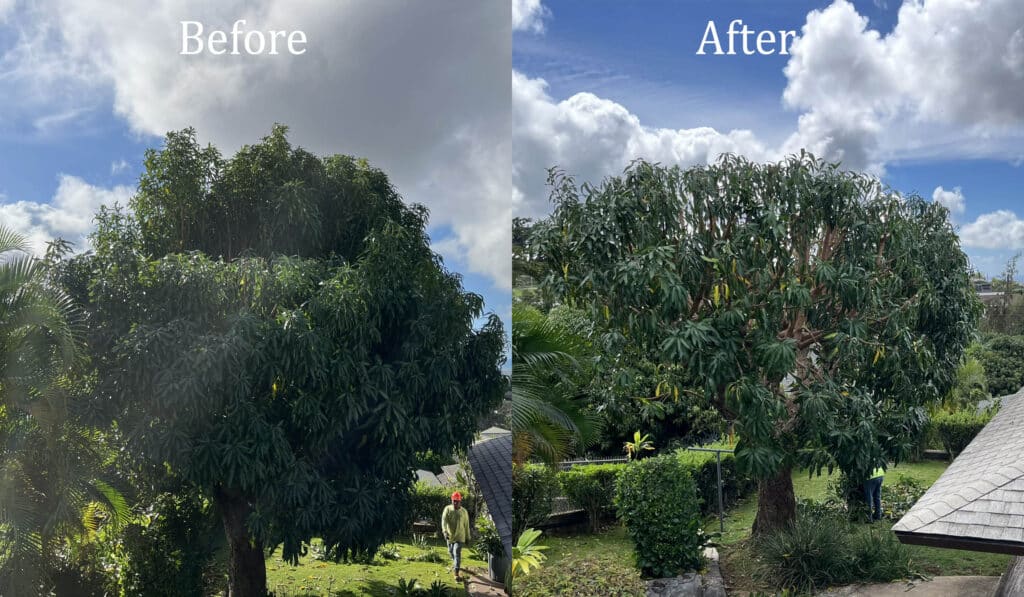In the heart of Hawaii, especially on Oahu, tree trimming transcends mere maintenance—it’s a blend of art and science. Arborists, with deep respect for nature, ensure each cut serves the tree’s health, safety, and the natural beauty of the islands.
Join us as we delve into the approach Certified Arborists take to preserve and enhance Hawaii’s lush landscapes.

1. Understanding Tree Species in Hawaii: A Tailored Approach
Each tree species in Hawaii’s diverse ecosystem has its own unique growth pattern and needs. Professionals adeptly tailor their trimming techniques to suit these varied species, ensuring that each tree not only survives but thrives in its environment.
2. Tree Health Evaluation: The Cornerstone of Effective Trimming
Early detection of diseases and pests is pivotal for maintaining tree health. Arborists conduct thorough evaluations, considering a tree’s age and overall condition, with a special focus on preserving Oahu’s iconic, ancient trees.
3. Prioritizing Safety: A Dual Focus
Safety is paramount, both for property owners and the arborists at work. From conducting risk analyses to prevent damage to structures and utility lines, to adhering to rigorous safety protocols in challenging conditions, this commitment ensures a harm-free environment.
Read Post Storm Tree Safety In Hawaii
4. Aesthetic and Functional Goals: Crafting Nature’s Masterpieces
Tree trimming in Hawaii aims to enhance the tree’s natural beauty while maintaining its health and vigor. Arborists strike a delicate balance between aesthetic appeal and the functional growth of trees, enriching Hawaii’s already stunning landscapes.
5. Legal and Environmental Considerations: Trimming with Conscience
Adherence to local laws and regulations is just the beginning; environmental sustainability remains at the forefront of every decision. This respect for Hawaii’s ecological values ensures that tree trimming practices promote the long-term health of the environment.
6. Long-term Tree Health in Oahu
With an eye on the future, professionals plan trimming activities to accommodate Hawaii’s unique environmental challenges, advocating for regular maintenance to ensure trees can withstand the tropical climate.
7. The Art of Trimming: Tools and Techniques for Perfecting the Canopy
Trimming a tree is a careful process that requires the right tools and methods to ensure the health of the tree and the safety of the arborist. Here’s a look at how professionals approach the task:
Selecting the Right Tools
The choice of tools depends on the size of the tree, the thickness of the branches, and the specific trimming goals. Common tools include:
- Hand pruners and loppers: Ideal for small to medium-sized branches, offering precision cuts without damaging the tree.
- Chainsaws: Used for larger branches, requiring skilled handling to ensure clean cuts and minimize stress on the tree.
- Pole saws: Allow for trimming higher branches from the ground, combining safety with efficiency.
Professionals always ensure their tools are sharp and clean to promote healthy healing in trees.
Accessing the Canopy

Reaching the branches that need trimming is a challenge in itself. Arborists typically use one of the following methods:
- Climbing: Using climbing gear such as ropes, harnesses, and spikes, arborists can navigate the tree safely. This method allows for close inspection and precise trimming but requires significant skill and training.
- Aerial lifts: For taller trees or those in difficult-to-reach areas, lifts can provide safe access to the canopy without damaging the tree’s structure.
Read Essential Palm Tree Trimming Tips
Trimming Techniques
Effective tree trimming in Hawaii is more than just removing branches; it’s about promoting the tree’s health and aesthetic appeal. Arborists follow a few key principles:
- Thinning: Removing select branches to increase light penetration and air flow through the canopy.
- Raising: Trimming lower branches to clear space for vehicles, pedestrians, and buildings.
- Reduction: Reducing the size of the tree, typically for utility line clearance or to reduce the risk of storm damage. This requires careful planning to maintain the tree’s structural integrity and appearance.
Conclusion: Tree trimming in Hawaii is an intricate dance with nature, requiring expertise, foresight, and respect for the living landscape. It’s not merely about cutting branches—it’s about nurturing the tree’s life and, by extension, the beauty of the islands.


